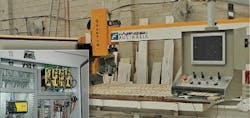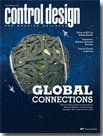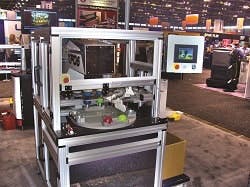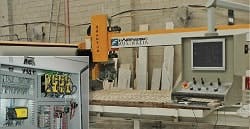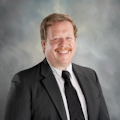Over time, we've seen understanding of the many rules and standards — those critical details that can open or bar the entrance to international markets — get a little better, and there clearly are more avenues of opportunity. However, when designing, selling and delivering machines to new users worldwide, it's more important than ever to have a good guide along for the ride. Helpful companions and partners are particularly crucial as the economic world shrinks, old trade barriers fall, and safety and other standards harmonize. This is because builders must seize opportunities and make decisions faster than ever to serve new markets full of new customers, who all want the same products as consumers in developed industrial markets.
Jim Montague is the executive editor for Control. Email him at [email protected].
SEE ALSO: Why Machinists Are Afraid to Participate in Worldwide Markets
In fact, these economic demands are so strong that they can push manufacturers and their machine builders to not just develop new equipment, but to reorganize and establish entirely new companies — and do it repeatedly as needs evolve and capabilities wax and wane across national boundaries.
Builders Trade Roles
Pad Print Machinery of Vermont (PPMOVT) in East Dorset, Vt., started out more than 20 years ago distributing pad printing machines from an Italy-based machine builder. Over the years, PPMOVT added increasing levels of automation and servomotors to its pad printers, and more recently developed industrial inkjet technology to meet users' requirements. Pad printers typically print on irregular surfaces and different materials, including ceramics, textiles and plastics.
- Constant Automation Companions
- Some Direction on European Directives
Now, PPMOVT uses the Italian OEM's printing heads to build machines with added automation fertures for complete printing systems. For example, Pad Print's KP06 ink-print, pad-printing machine retains the OEM's frame and mechanicals, but Pad Print revamps and can customize them with its own auto-loading and unloading, pretreating, rotating parts tables and other devices (Figure 1). Pad Print's machines and servos integrate PC-based controls and PLCs from several controls manufacturers to control process graphics data, oversee the printer heads, and manage I/O components. They also use servomotors and drives to run conveyors and printer heads, and incorporate large and smaller robots for other tasks.
"We began R&D on inkjets, branched out, and started our inkjet division eight years ago because industrial inkjets mean pretty much instant setup of 10-20 seconds for our users, who are mostly printing on medical devices," says Julian Joffe, Pad Print's CEO. "We were one of the first companies to print without the usual plates, but setup was still about two minutes without color and up to 90 minutes or more for multicolor pad printing. Inkjets are all-digital with no analog controls or plates, which eliminates most of the former setup time, and enables automatic loading and running of product. We're even doing inkjet printing on bottlecaps and cylinders, which used to be the most difficult to print on. And, we're using more sophisticated inks, which have better adhesion on more surfaces, and we're curing them with better-focused LED lights that are more reliable and use less power."
Ironically, all of Pad Print's inkjet and related innovations have even inspired the Italian OEM to reverse its traditional supply chain, and begin selling Pad Print's inkjet machines to its clients in Europe. "Making the switch from just pad printing to adding inkjets was a big opportunity that took lots of vision, but now others are following into a market that's a lot bigger for all of us," Joffe explains. "Doing inkjets was too big a blow to some builders' egos, but we've always been pretty hungry. We knew we'd be left behind if we didn't change, and we decided we'd rather get there first and compete with ourselves instead of competing with someone else."
When in Rome — Follow the Rules
No doubt the first rule of international machine marketing and sales is: find out what the local regulations and standards are, and follow them as closely as possible.
"Providing machines globally means complying with many different codes, especially in Europe," says Joel Weiss, tradeshow manager at Haas Automation. Haas builds its CNC machining centers in Oxnard, Calif., but sells and services them via 170 independently owned and operated Haas Factory Outlets (HFOs) worldwide, including 110 outside the U.S. "Besides operating regulations, there are rules about taxes, importing and customs, and we have to understand and work with all of them."
Figure 1: Pad Print Machinery of Vermont's KP06 printing machine adds automation options to an Italian pad printing machine, and customizes it with Pad Print’s automation, servos, auto-loading and unloading, pretreating and rotating parts tables.
Source: Jim Montague
Joffe adds, "We have a good relationship with our Italian OEM, but we still have to be aware and follow applicable regulations. As we started to ship more to Europe, we had to make sure to use all CE-certified parts, whereas our supplier does self-certifications. Likewise, Canada is also a good market, but it can be difficult because machines must be certified by the Canadian Standards Assn.. For example, if you ship gas-fueled equipment, CSA can be very picky about how pretreating devices employ natural gas or propane. We always build machines with regard to safety, and we're glad the main international machine safety standards have been harmonized recently."
Similarly, Jon Ertle, sales manager for Criterion Manufacturing Solutions in Comstock Park, Mich., reports his firm's CNC routers and gauging equipment for coordinate measuring machines (CMMs) only travel as far as Mexico and Canada, but they still must comply with different standards and rules. "We mostly get into international markets by following our U.S. customers to their plants there," Ertle explains. "We're building a robot cell for a Canadian user that does material handling and palletizing. We needed to meet different specifications, and comply with CSA's D43403 safety standard for robotics. So, we just went to CSA's website, got access to the applicable standards, and learned how to meet their safety requirements. We found out that, since we were already building safe equipment in the U.S., there wasn't much of a difference."
While there are many standards that builders must follow for different types of machines and applications, the latest, unified, comprehensive safety standard is EN ISO 13849-1. It begins with conducting a risk assessment (RA), identifying all risk sources for each operation, and making a risk estimate for each. EN ISO 13849-1 estimates risk using three well-known factors: injury severity, frequency of exposure to the risk, and the possibility of avoiding or limiting the injury. While understanding EN ISO 13849-1's calculations isn't difficult, there are software and online tools that are quite helpful. For example, the free Sistema software utility from the German Social Accident Insurance organization's Institute for Occupational Safety and Health gives developers and testers of safety-related machine controls support in evaluating safety in the context of ISO 13849-1.
Figure 2: After providing its water-cutting systems through partners for several years, Waterjet just opened its own sales, service and parts facility on July 3 in Geneva, Ill.
Source: Waterjet
Set Up Shop or Distribute?
Despite the advantages of contracting with local organizations to represent, resell or private label machines, many builders prefer to ship from home, open branch offices when the time is right, and then sometimes transition to building machines in their new homes.
For example, Waterjet, based in Monza, Italy, built two- to six-axis cutters (Figure 2) for the North American market for several years, using high-pressure intensifier technology from KMT Waterjet, and selling its table-based systems through Mitsubishi-owned M.C. Machinery in Wood Dale, Ill. But, after succeeding with this third-party partnership, Waterjet just opened its own sales, service and parts subsidiary, Waterjet USA in Geneva, Ill.
"This is an opportunity to earn market share," says Massimo Denipoti, president of Waterjet USA. "We build small to very large tables and machines from two to six axes, and the number of companies in the U.S. market that can offer similar solutions is very limited. Factory service personnel are being relocated to Geneva to consolidate our local installation team and post-sales people. Also, we'll be within easy reach of the service crew at KMT."
Likewise, Hurco in Indianapolis, Ind., reports it maintains a global distributor network, including a 34-year presence in Europe, for its CNC machining centers and turning centers that are designed to make the manufacture of small to medium lot sizes more profitable. Instead of making the controls and sourcing the machining centers, the company decided to "make its own iron" in 1986, and in 1999, it decided to open an assembly facility in Taiwan.
"Indianapolis is our worldwide headquarters where all our machine design, R&D, and software development takes place, but establishing our Taiwan subsidiary gave us great economies of scale and lowered our assembly costs," says Phil Fassnacht, Hurco's marketing director. "Now, we still assemble machines in Taiwan, ship them worldwide to North America, Europe and Asia, and make sure they meet the standards required in the market where they'll be installed."
Haas' Weiss adds, "We have people on staff who closely analyze global markets, and evaluate the best locations and times to open regional Haas headquarters to support the local HFOs. These regional headquarters are staffed by Haas employees, and include showrooms for demonstrating machines, spare parts inventories, warehouse space, training facilities, and service and applications departments. Our goal is to provide complete support to the local HFOs, so they can provide better service to their own customers.
"We've been waiting for the European market to come back, and it's starting to turn positive. We've been in India and China for close to 10 years, but we're still learning to do business wisely. More recently, we're also looking at Russia, South America and Southeast Asia as possible areas to establish regional headquarters. So far, we've established a number of HFOs in those regions, with service and support provided directly through Haas Corporate in Oxnard."
Weiss adds the decision to open a regional headquarters depends on estimated sales volume and how easy it will be to manage within a certain territory. "It usually doesn't make sense to set up a subsidiary right away," Weiss says. "The local HFOs will know what to do for their markets, and if the territory turns out to be large and expansive enough, then it may make sense to set up a headquarters there. Initially in China, we had a network of local distributors that was serviced from Oxnard, but the market had such huge potential, that we decided to open a Haas headquarters there."
Figure 3: Farnesse Australia tries to have a standard design for the whole world, and then slightly modify it when needed. Its Quantum CNC bridge saw uses motion controllers and servo motors and drives to cut, drill and polish stone drain board and cut-outs for sinks, stoves, basins and showers.
Source: Baldor
Streamline With Common Designs and Support
Just as harmonized safety standards make it easier for machine builders to focus on one protection strategy for several regions, one unified design can also help builders assemble and maintain equipment at multiple sites worldwide.
Farnese Australia in Ingleburn, near Sidney, builds stone-cutting and polishing machines, and it recently found that uniform technical support globally can help it move into new markets. For example, Farnese's latest Quantum CNC bridge uses Baldor's Ethernet-based motion controllers, servo drives and brushless servomotors to achieve four-axis control.
"With built-in, real-time Powerlink Ethernet, the controller can do interpolation on up to 16 axes, which is far more than we need at this stage, but is still cost-effective for us," says Alesandro Farnese, manager of Farnese Australia. "As result, we compete successfully against larger European manufacturers, and we believe the reasons for our success include our locally developed HMI and our ability to deliver fast, local support. Our current expansion plans include selling into Europe, and because Baldor has a well-established international support network, we can install its technology, and be sure our customers can get support worldwide."
As part of this effort, Farnese is pushing ahead with a manufacturing plant in Vietnam, employing more than 30 people to produce machines for European markets. "The new factory will allow us to concentrate our Australia-based expertise on improving our designs, so we can gain and maintain a competitive edge in the world market," Farnese says.
Hurco's Fassnacht adds, "We seek to have standard designs for the whole world that we can easily modify for each market as needed. In fact, this strategy promotes the corporate agility that's helped us be successful, especially navigating the cyclical nature of the machine tool business in different regions. For example, Europe accounted for 73% of our sales in 2008, but just 58% last year. So, when the recovery started in North America and the European market remained stagnant, due largely to the worldwide recession compounded by the European debt crisis, we were able to easily reconfigure the machines for North America."
About the Author
Jim Montague
Executive Editor, Control
Jim Montague is executive editor of Control. He can be contacted at [email protected].

Leaders relevant to this article:
